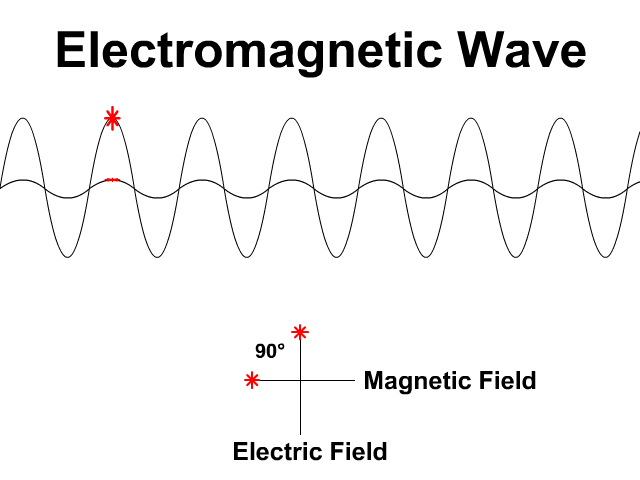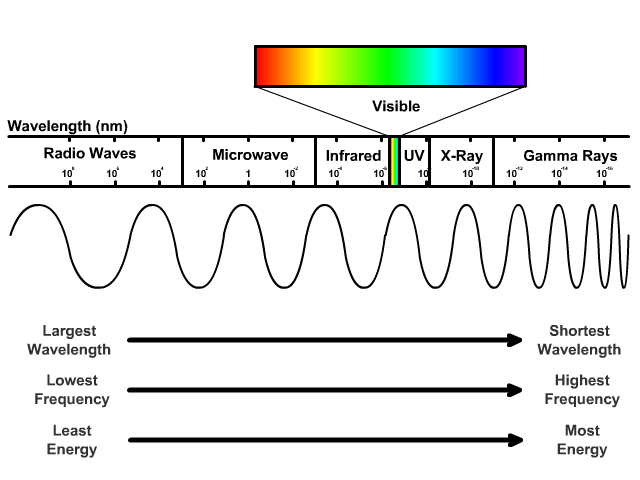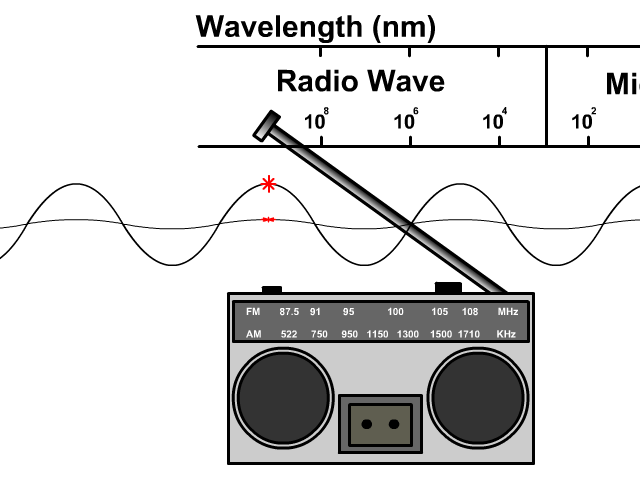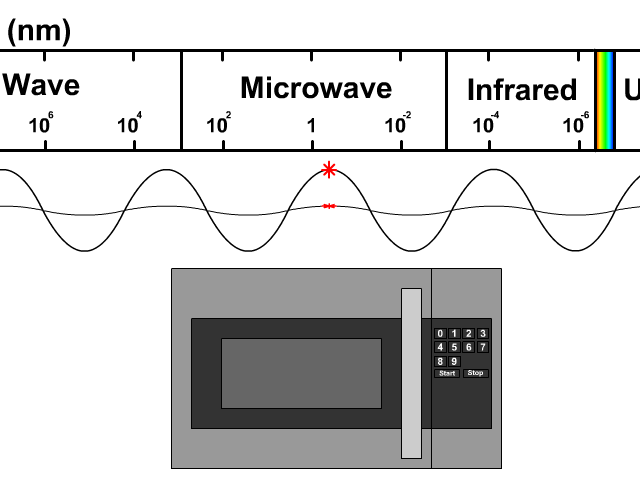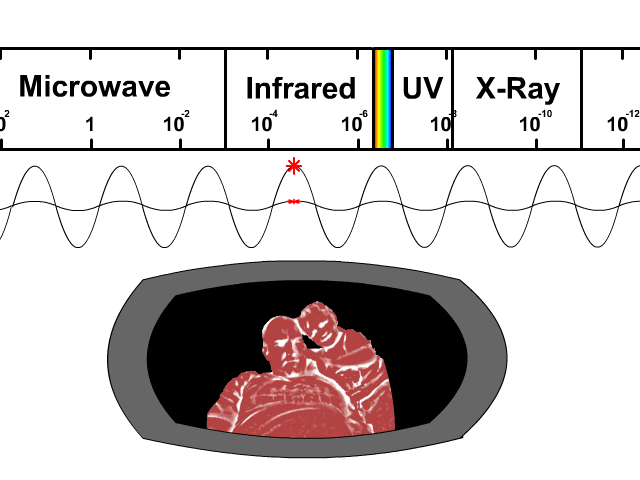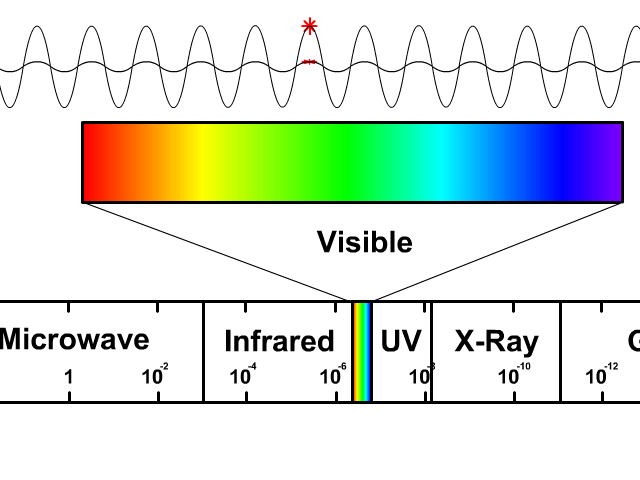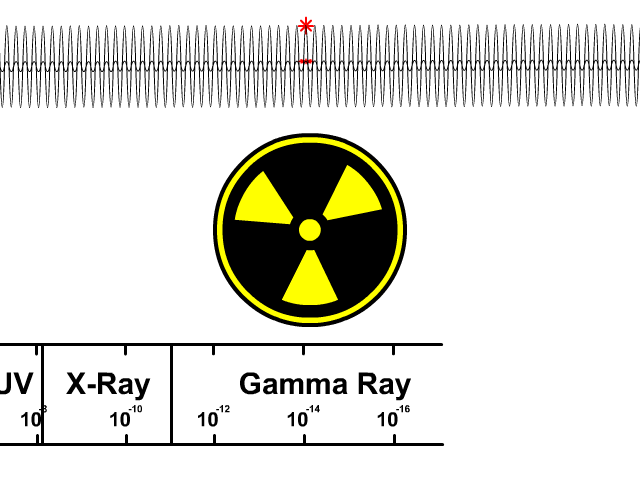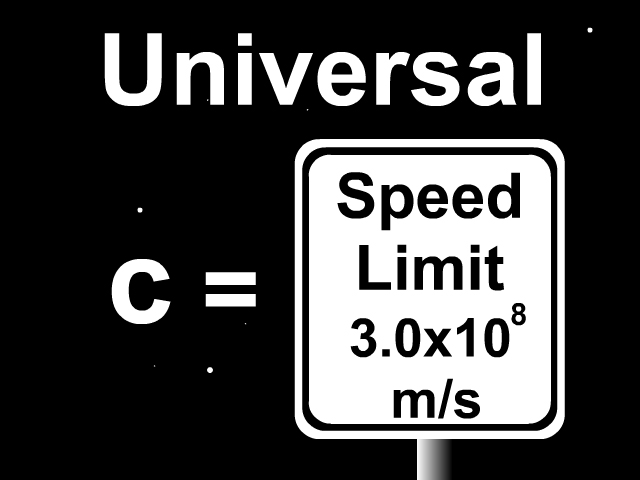Waves of the Electromagnetic Spectrum
Waves of the electromagnetic spectrum have similar and different properties. Learn these and answer basic math problems about electromagnetic waves.
Follow a video of this lesson clicking on the YouTube video here.
Tour of the EMS (Electromagnetic Spectrum)
Watch a short clip about the electromagnetic spectrum (EMS). Even though electromagnetic (EM) waves are around us, many of these frequencies are invisible. This is because our eyes only sense a little part of it called visible light.
Electromagnetic Wave Structure
Electromagnetic waves transfer energy and are created by vibrating charged particles.
A static charge creates an electric field and a moving charge creates a magnetic field. The result of a vibrating charged particle is both a transverse electric field and magnetic field wave.
The electric field and a magnetic field in an electromagnetic wave vibrate perpendicular (90°) to each other.
Range of Electromagnetic Waves
The types of electromagnetic waves from longest wavelength to shortest are Radio, Infrared (IR), Visible Light, Ultraviolet (UV), X-Ray, and Gamma Ray waves. Frequency of a wave is inversely proportional. So from highest frequency to lowest frequency would be reverse of the order above. Higher frequency contain more energy so gamma rays have the most energy and radio waves have the least. The more energy contained in the wave the more penetrating power. Ultraviolet through gamma rays these EM waves become increasingly penetrating and dangerous.
Radio Waves
Radio waves have the longest wavelength in the electromagnetic spectrum with the lowest frequency. They have the least energy which is associated with frequency. Radio waves are not sound waves. A device called a "radio" detects radio waves and converts that signal into what a speaker turns into sound.
FM stands for “Frequency Modulation” and what you read on the radio dial is MHz, which is 1000000 Hz or waves per second.
AM stands for “Amplitude Modulation” and what you read on the radio dial is KHz, which is 1000 Hz or waves per second.
The TV is another device that uses a frequency that is a radio wave.
Microwaves
Microwaves have a shorter wavelength and greater frequency and energy than radio waves.
A device called a "microwave" uses energy in microwaves to vibrate food molecules, heating them up.
Infrared Waves
Infrared (IR) waves have the next shortest wavelength after microwaves and greater frequency and energy.
Infrared waves are commonly used in devices like remote controls to transmit a signal in the IR range. Night vision cameras and goggles detect infrared given off by warm blooded organisms so you can detect them.
Visible Light Waves
Visible light has the next shortest wavelength after Infrared and a greater frequency and energy.
Why cant you see all the waves in the electromagnetic spectrum?
Your eyes are organs that detect only a frequency in the visible light spectrum of the electromagnetic waves. Different frequencies of visible light are detected as different colors. You will see more about this in a future lesson.
Ultra Violet Waves
Ultraviolet (UV) waves have the next shortest wavelength after visible light and a higher frequency and energy.
With more energy these waves become a bit more dangerous as they can penetrate further into objects at the molecular level including our skin. UV waves are considered a mutagen that can alter DNA and increase the risk of cancer.
Waves will get increasingly energetic, penetrating, and dangerous as frequency increases from ultra violet light, to X-Ray, and finally Gamma.
Energy from the sun includes UV rays. Tanning beds also use UV light which your skin reacts to. Some devices use UV light to sterilize surfaces and objects of microorganisms.
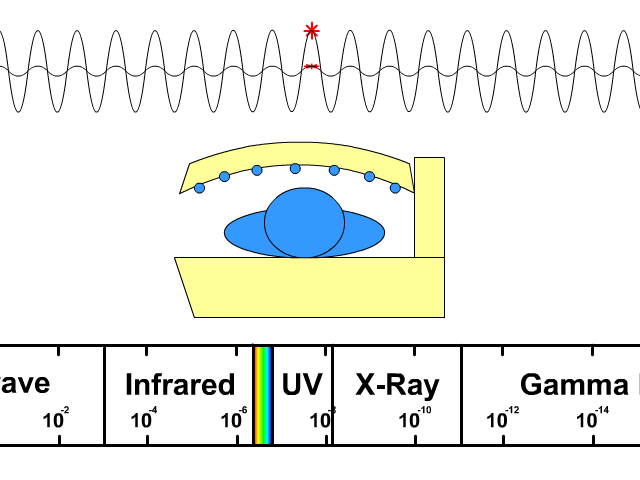
X-Ray Waves
X-rays have the next shortest wavelength after visible light and higher frequency and energy.
X-rays have additional penetrating power and are more dangerous. X-rays can not get through lead which is why they cover up any unnecessary area during a medical X-ray.
An X-ray machine uses X-ray waves to penetrate through an object. X-rays pass through less dense objects and get absorbed by more dense objects. In a medical X-ray your dense bones can be seen on film.
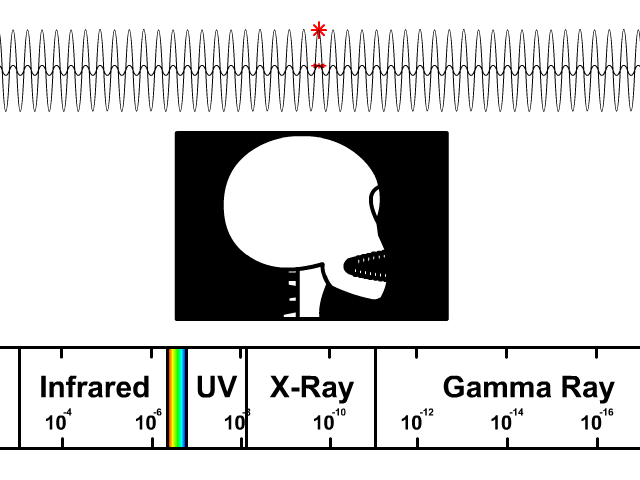
Gamma Ray Waves
Gamma rays have the shortest wavelength and highest frequency and highest energy of all electromagnetic waves.
Gamma rays are mostly produced in nuclear reactions. These reactions include fusion, fission, alpha decay, and gamma decay.
Gamma rays are the most penetrating due the there excessive frequency and energy. Newly developing cells are often destroyed by gamma rays. Cancer occurs when cells loose their ability to stop dividing.
Radiation therapy is used as medical treatment to kill newer cancer cells. These cancer cells are younger and more prone to destruction than the more mature cells of the human body.
EM Wave Questions
1. Does a radio wave or visible light have a higher frequency?
2. Does an X-ray or microwave have a longer wavelength?
3. Does infrared or ultraviolet have greater energy?
4. Is an X-ray or microwave more penetrating and dangerous?
Speed of an Electromagnetic Wave
The speed of all electromagnetic waves in the vacuum of space is 300,000,000 m/s or 3.0 x 108 m/s. This is the universal speed limit and often called the speed of light. This velocity is also the speed of radio waves, microwaves, infrared, visible light, ultraviolet, X-Ray, and Gamma Rays.
The speed of light in a vacuum, 3.0 x 108 m/s, is a special constant given the variable (c). In air light slows down marginally to 299,792,458 m/s which still rounds to 3.0 x 108 in our calculations. Use 3.0 x 108 m/s for any EM wave in your velocity equations, v=x/t and v=𝜆f, that are in air or space.
c = 3.0 x 108 m/s
Velocity (v) of any EM wave in space or air is 3.0 x 108 m/s
Example Problems
5. What is the wavelength of a 5.2 x 105 Hz AM radio wave?
6. What is the wavelength of a 1.5 x 106 Hz AM radio wave?
7. Does a 5.2 x 105 Hz or 1.5 x 106 Hz AM radio wave have a longer wavelength?
8. What is the frequency of an electromagnetic wave that has a wavelength of 10,000 m?
9. How long does it take for light from the sun to reach earth if the sun is 1.5 x 1011 m away?
10. If the speed of a wave remains constant and the wavelength (𝜆) triples, how will the frequency compare to the original?
Links
- On to the Colors of Light
- Back to the Main Electromagnetic Waves Page
- Back to the Stickman Physics Home Page
- Equation Sheet

